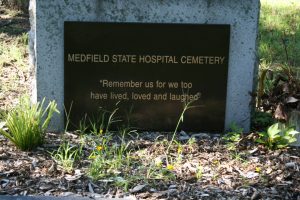New England Institutions – Aug ’10
I flew into Boston, Saturday Aug 21st, stayed on Cape Cod for the evening, then drove up to Plainfield, VT where I used to go to college. On Monday, I presented a workshop with one of my advisors for Goddard’s IBA program. Our workshop was on mental illness and women. We showed the documentary Dialogues with Madwomen by Allie Light (http://www.brightlightsfilm.com/14/madwomen.php). If you haven’t seen it, it is a difficult and wonderful film!
Tuesday Aug 24th, I drove from my alma mater down to Brattleboro Retreat (http://www.youtube.com/watch?v=hjRB6kF8K0M). It is one of the older institutions in the U.S. built in 1837. It bases its treatment on moral therapy. It is also a private institutions and not state funded. This makes a huge difference in the attitude and condition of the institution. It was very clean and well kept… had the appearance of being a school rather than a hospital. The average length of stay is 8 days. It was clear that this institution has money and is not struggling in the same way that the state funded hospitals are. I was informed that, in fact, it had been growing in size. My feeling of this institution was that of privilege. Everything appeared pretty and pleasant, growing in population and increasing efficiency. People, who have the privilege, often choose to go to this institution from all over New England. In fact, it is referred to, along with a handful of other institutions, as “ivy league.” It is fitting and somewhat humorous… I’ll let you fill in the rest here.
It was very clean and well kept… had the appearance of being a school rather than a hospital. The average length of stay is 8 days. It was clear that this institution has money and is not struggling in the same way that the state funded hospitals are. I was informed that, in fact, it had been growing in size. My feeling of this institution was that of privilege. Everything appeared pretty and pleasant, growing in population and increasing efficiency. People, who have the privilege, often choose to go to this institution from all over New England. In fact, it is referred to, along with a handful of other institutions, as “ivy league.” It is fitting and somewhat humorous… I’ll let you fill in the rest here.
In stark contrast to Brattleboro, Vermont State Hospital has been reduced to just a tiny fraction of its former self. The campus remains largely in tact, but the buildings have been handed over to other state offices for use. The hospital now operates out of one building, out of over 30, and has 55 beds. They have been stripped of their certification as a state hospital because quality of care is unfit. It will likely be shut down in the next years. A new facility is being planed on site which will house 15 beds for very acute patients. The rest of the patients will be sent to other regional facilities. Clearly there is no longer the same need for giant institutions but with the closing of VSH, care is being pushed to regional treatment center and back out onto the streets/prisons. The biggest problem is that the other regional facilities have been sending their violent acute patients to VSH because they could not handle them… now these same patients will be sent back. How is this expected to work? As VT’s 2010 governor elections are underway this is one of the hot topics and an interesting and important topic of debate (http://www.cctv.org/watch-tv/programs/democratic-primary-governo) at about 11 ½ minutes into the debate.
Mental health carries with it a whole list of stigma’s. Its history carries a lot of missteps, mistakes, and bad choices. In generaI I would say that the majority of these mistakes, though having negative outcomes/effects, come from a place of positive intent and intention. Health care practitioners for the most part are doing the best that they can with the information, technology, and resources that they have available to them. It is clear that the personnel at VSH care desperately about the standard of care they provide. And they are doing the best that they can with the resources that they have been provided with. These resources continue to be cut. How are they expected to maintain a standard of care when they they are struggling to survive. Perhaps other regional treatment centers are the answer, but if funding continues to be cut, how will even these places survive? What is the outcome for mental health care as a whole if we are not willing to make it a priority?
Out of Vermont and onto New Hampshire… Visiting New Hampshire State Hospital provided another image of the giant historic institutions closing. But unlike VSH, NHSH has transitioned from old to new. It moved out of the old buildings almost entirely and into a new facility on site. The old campus is also now used for other state offices. I do not have information about how this transition impacted care positive or negatively. And I openly recognize that change is not always bad.
Visiting New Hampshire State Hospital provided another image of the giant historic institutions closing. But unlike VSH, NHSH has transitioned from old to new. It moved out of the old buildings almost entirely and into a new facility on site. The old campus is also now used for other state offices. I do not have information about how this transition impacted care positive or negatively. And I openly recognize that change is not always bad.
What I will acknowledge is that regardless of this transition, the buildings of the old hospital are struggling . Some parts of the buildings at NHSH are well maintained and used for offices. Other parts are crumbling and collapsing. Repairs for these buildings cost hundreds-of-thousands up to millions of dollars per project. Remember, the buildings are huge and old, things break… the State can’t afford many of these repairs so work is prioritized. Quick fixer-uppers often replace more costly repairs. Maintenance works hard to keep things functioning. Still from an outside perspective with admittedly no engineering training, some the repairs seem questionable. Cost cutting clearly impacts the aesthetic and historical value, but is it also impacting safety?
On Friday I headed up to Maine to photograph Dorothea Dix Psychiatric Center, formerly Bangor (Pronounced “Bang-gor” not “Banger” as I was politely corrected) State Hospital.  The hospital was beautiful and well maintained. This was a good balance of state funded hospitals, not as privileged as privately funded institutions, but still operating under under what would appear to be positive and not dire conditions.
The hospital was beautiful and well maintained. This was a good balance of state funded hospitals, not as privileged as privately funded institutions, but still operating under under what would appear to be positive and not dire conditions.
I swung by Augusta State Hospital, now Riverview Psychiatric Center, on the way back to Boston. I couldn’t get access to this hospital, kept getting the run around of who to talk to in order to get permission. I felt as if they were perhaps uninterested in the history of their facility or had something they didn’t want to be photographed. I was able to get a few photographs from the bridge across the river from the hospital. Beautiful old buildings… after having such a positive experience at Dorothea Dix Psychiatric Center, I wonder why Riverside keeps itself so guarded. What does their history hide or what do they wish to hide of their history?
On Saturday I was finally able to visit Medfield State Hospital in Massachusetts. I had attempted to photograph this institution when I was working on my senior study at Goddard in ’08 but it had been closed because they were filming Shutter Island there at the time. The hospital is completely closed and abandoned. The buildings are boarded up and many are condemned. The grounds are open for the public to walk around between 6am and 6pm as long as people don’t go near/into the buildings as many of them are asbestos filled or structurally unsound. The campus is huge (54 building?) and has the illusion of continue onward in the horizon as the next building appears behind the last. Ivy grows rampant and the grass is unkept. A beautiful campus, secrets and stories covered in ivy and dust, decaying, and perhaps soon to be forgotten.


Leave a Reply
You must be logged in to post a comment.